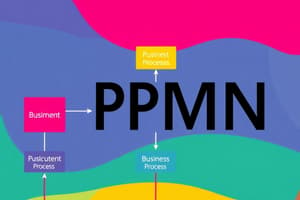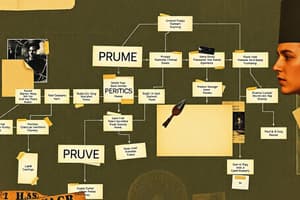Podcast
Questions and Answers
What does a class diagram describe in UML?
What does a class diagram describe in UML?
- The physical resources in a system
- The dynamic behavior of a system
- The interactions among classes over time
- The static structure of a system (correct)
Which UML diagram is used to organize elements of a system into related groups?
Which UML diagram is used to organize elements of a system into related groups?
- Package diagram (correct)
- Activity diagram
- Component diagram
- Object diagram
Which UML diagram describes the organization of physical software components?
Which UML diagram describes the organization of physical software components?
- Composite structure diagram
- Communication diagram
- Class diagram
- Deployment diagram (correct)
What does an activity diagram illustrate in UML?
What does an activity diagram illustrate in UML?
Which of the following UML diagrams can be used to test class diagrams for accuracy?
Which of the following UML diagrams can be used to test class diagrams for accuracy?
What does a composite structure diagram show?
What does a composite structure diagram show?
Which UML diagram describes interactions among classes in terms of message exchanges?
Which UML diagram describes interactions among classes in terms of message exchanges?
What is the primary focus of behavioral UML diagrams?
What is the primary focus of behavioral UML diagrams?
What are the two classifications of an event?
What are the two classifications of an event?
Which of the following best defines an activity in BPMN?
Which of the following best defines an activity in BPMN?
What does a data object signify in BPMN?
What does a data object signify in BPMN?
What is the purpose of a group in BPMN?
What is the purpose of a group in BPMN?
What is the role of annotations in a BPMN diagram?
What is the role of annotations in a BPMN diagram?
What concept involves class diagrams in system structure?
What concept involves class diagrams in system structure?
Which of the following describes dynamic behavior in systems?
Which of the following describes dynamic behavior in systems?
Which of the following statements is true regarding swimlanes in BPMN?
Which of the following statements is true regarding swimlanes in BPMN?
What is the primary purpose of Business Process Model and Notation (BPMN)?
What is the primary purpose of Business Process Model and Notation (BPMN)?
Which type of flow in BPMN shows the communication between different organizational departments?
Which type of flow in BPMN shows the communication between different organizational departments?
What distinguishes a pool in a BPMN diagram?
What distinguishes a pool in a BPMN diagram?
Which of the following is NOT a type of event in BPMN?
Which of the following is NOT a type of event in BPMN?
What does a gateway represent in BPMN?
What does a gateway represent in BPMN?
What type of flow is represented by associating an artifact or text to an event in BPMN?
What type of flow is represented by associating an artifact or text to an event in BPMN?
Which statement about BPMN is FALSE?
Which statement about BPMN is FALSE?
Which type of flow in BPMN indicates the order of activities to be performed?
Which type of flow in BPMN indicates the order of activities to be performed?
Which property of Architecture Description Languages (ADLs) involves integration of various elements such as assertion and implementation?
Which property of Architecture Description Languages (ADLs) involves integration of various elements such as assertion and implementation?
What property of ADLs limits communication to certain components?
What property of ADLs limits communication to certain components?
Which property of ADLs allows for systematic organization of complex architectures?
Which property of ADLs allows for systematic organization of complex architectures?
Which of the following properties involves the use of protocols in ADLs?
Which of the following properties involves the use of protocols in ADLs?
What is a key function of the property that allows ADLs to analyze performance and behavior?
What is a key function of the property that allows ADLs to analyze performance and behavior?
What is the primary function of a use case diagram?
What is the primary function of a use case diagram?
Which diagram is specifically designed to show the dynamic behavior of a system in response to external stimuli?
Which diagram is specifically designed to show the dynamic behavior of a system in response to external stimuli?
What type of diagram combines elements of both an activity and a sequence diagram?
What type of diagram combines elements of both an activity and a sequence diagram?
Which organization is responsible for overseeing the definition and maintenance of UML specifications?
Which organization is responsible for overseeing the definition and maintenance of UML specifications?
What does a timing diagram focus on?
What does a timing diagram focus on?
What is the main purpose of Architecture Description Language (ADL)?
What is the main purpose of Architecture Description Language (ADL)?
What type of diagram primarily illustrates user-based functionalities of a system?
What type of diagram primarily illustrates user-based functionalities of a system?
Which of the following statements about ADLs is true?
Which of the following statements about ADLs is true?
Flashcards
BPMN
BPMN
Standardized notation for business processes, used for communication between business and technical users.
Flow Object (BPMN)
Flow Object (BPMN)
Element in a BPMN diagram that starts, modifies, or completes a process (e.g., event, activity, gateway).
Event (BPMN)
Event (BPMN)
A trigger in a business process (e.g., a message arrives, a timer expires).
Activity (BPMN)
Activity (BPMN)
Signup and view all the flashcards
Gateway (BPMN)
Gateway (BPMN)
Signup and view all the flashcards
Sequence Flow (BPMN)
Sequence Flow (BPMN)
Signup and view all the flashcards
Message Flow (BPMN)
Message Flow (BPMN)
Signup and view all the flashcards
Swimlane (BPMN)
Swimlane (BPMN)
Signup and view all the flashcards
Pool (BPMN)
Pool (BPMN)
Signup and view all the flashcards
Lane (BPMN)
Lane (BPMN)
Signup and view all the flashcards
Artifact (BPMN)
Artifact (BPMN)
Signup and view all the flashcards
Private BP (BPMN)
Private BP (BPMN)
Signup and view all the flashcards
Abstract BP (BPMN)
Abstract BP (BPMN)
Signup and view all the flashcards
Collaborative BP (BPMN)
Collaborative BP (BPMN)
Signup and view all the flashcards
UML
UML
Signup and view all the flashcards
Use Case Diagram (UML)
Use Case Diagram (UML)
Signup and view all the flashcards
Class Diagram (UML)
Class Diagram (UML)
Signup and view all the flashcards
Activity Diagram (UML)
Activity Diagram (UML)
Signup and view all the flashcards
Component Diagram (UML)
Component Diagram (UML)
Signup and view all the flashcards
Deployment Diagram (UML)
Deployment Diagram (UML)
Signup and view all the flashcards
ADL
ADL
Signup and view all the flashcards
Study Notes
Business Process Modeling Notation (BPMN)
- BPMN was developed by the Business Process Management Initiative (BPMI) and later taken over by the Object Management Group.
- It provides a standardized notation for business processes, allowing for communication between business and technical users.
- BPMN is designed to be used by stakeholders involved in designing, managing, and implementing business processes.
- The notation is flowchart-like and independent of any specific implementation environment, creating a bridge between design and implementation.
Element Types in Business Process Diagrams (BPMN)
- Flow Objects:
- Event: Trigger that starts, modifies, or completes a process. Includes types like message, timer, error, compensation, signal, cancel, escalation, link, etc.
- Activity: Represents a task performed by a person or system. Can include sub-processes, loops, and compensations.
- Gateway: Decision point that adjusts the path based on conditions or events. Can be exclusive, inclusive, parallel, complex, or based on data/events.
- Connecting Objects:
- Sequence flow: Shows the order of activities.
- Message flow: Depicts messages flowing across pools or organizational boundaries.
- Association: Associates an artifact or text to an event, activity, or gateway.
- Swimlanes:
- Pool: Represents major participants in a process, possibly from different companies or departments.
- Lane: Sub-part of a pool, defining accountability within the process by showing activities and flow for a specific role or participant.
- Artifacts:
- Data object: Shows necessary data for an activity.
- Group: Logical grouping of activities, but doesn't change the diagram's flow.
- Annotation: Provides further explanation for a part of the diagram.
Sub-Models within a BPMN Diagram
- Private BP: Internal processes within a specific organization, not crossing pools or boundaries.
- Abstract BP: Interactions between a private BP and an external participant or process, without showing the private BP itself.
- Collaborative BP: Interactions between two or more business entities.
Unified Modeling Language (UML)
- Established as a standardized language for specifying, visualizing, constructing, and documenting software systems, both structurally and behaviorally.
- Combines elements from the Booch method, Object-Modeling Technique (OMT), and Objectory.
- Primarily used by programmers, not typically by database developers.
- The Object Management Group (OMG) oversees its definition and maintenance.
Modeling Concepts Specified by UML
- Functional:
- Use Case Diagrams: Describe system functionality from a user's perspective.
- Object:
- Class Diagrams: Describe the structure of a system using objects, attributes, associations, and operations.
- Dynamic:
- Interaction diagrams: Describe internal system behavior through state machine diagrams and activity diagrams.
Types of UML Diagrams
- Structural UML Diagrams:
- Class diagram: Describes the static structure of a system.
- Package diagram: Organizes elements of a system into related groups.
- Object diagram: Models the static structure of a system at a specific time, testing class diagrams for accuracy.
- Component diagram: Organizes physical software components, including source code, run-time code, and executables.
- Composite structure diagram: Shows the internal parts of a class.
- Deployment diagram: Depicts physical resources in a system, including nodes, components, and connections.
- Behavioral UML Diagrams:
- Activity diagram: Illustrates the dynamic aspect of a system by modeling the flow of control from activity to activity.
- Communication diagram: Describes interactions among classes through message exchange over time.
- Use case diagram: Models system functionalities using actors and use cases, serving as a simplified version of collaboration diagrams.
- State machine diagram: Describes a system's dynamic behavior in response to external stimuli.
- Sequence diagram: Models interactions between objects in a sequential order.
- Interaction overview diagram: Combines aspects of activity and sequence diagrams for modeling complex interactions.
- Timing diagram: Focuses on processes occurring within a specific time period, showing time increasing from left to right.
Architecture Description Language (ADL)
- Refers to formal languages used for describing and modeling software architectures formally.
- A good ADL should provide abstraction for modeling large systems.
- Different ADLs exist, each with distinct concepts and suitability for technically-oriented users.
- Examples include UniCon, Wright, and Acme.
Important Properties of ADLs
- Ability to represent components, their properties (assertions), interfaces, and implementations.
- Ability to represent connectors, including protocols, property assertions, and implementations.
- Abstraction and encapsulation for components and communication.
- Openness to accommodate analysis tools.
- Limiting communication to architecturally connected components.
- Modeling dynamic architectures.
- Reasoning about causality and time.
- Support for hierarchical refinement.
- Ability to check conformance.
Studying That Suits You
Use AI to generate personalized quizzes and flashcards to suit your learning preferences.




